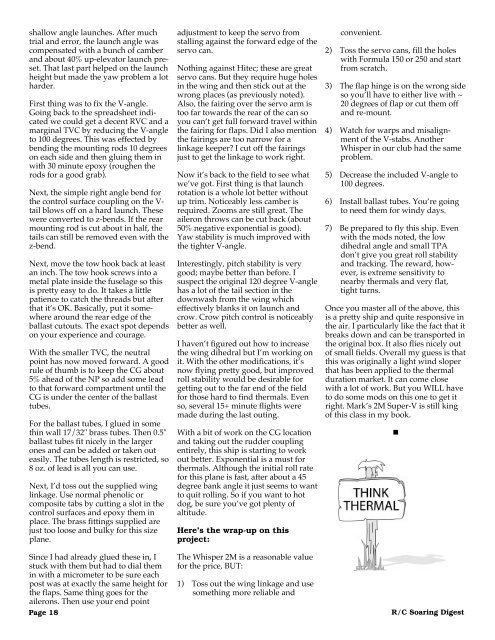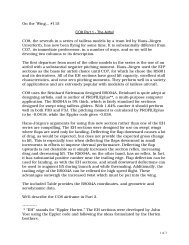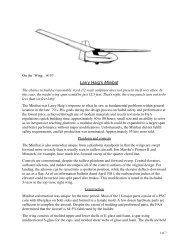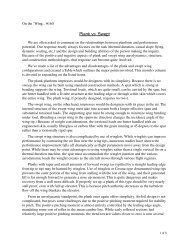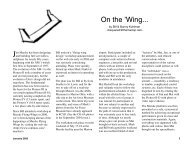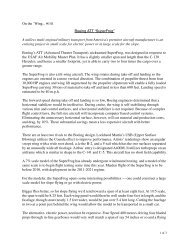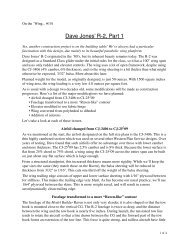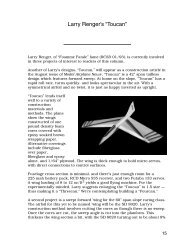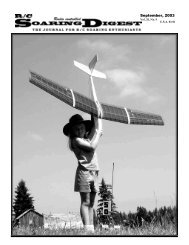shallow angle launches. After muchtrial and error, the launch angle was<strong>com</strong>pensated with a bunch of camberand about 40% up-elevator launch preset.That last part helped on the launchheight but made the yaw problem a lotharder.First thing was to fix the V-angle.Going back to the spreadsheet indicatedwe could get a decent RVC and amarginal TVC by reducing the V-angleto 100 degrees. This was effected bybending the mounting rods 10 degreeson each side and then gluing them inwith 30 minute epoxy (roughen therods for a good grab).Next, the simple right angle bend forthe control surface coupling on the V-tail blows off on a hard launch. Thesewere converted to z-bends. If the rearmounting rod is cut about in half, thetails can still be removed even with thez-bend.Next, move the tow hook back at leastan inch. The tow hook screws into ametal plate inside the fuselage so thisis pretty easy to do. It takes a littlepatience to catch the threads but afterthat it’s OK. Basically, put it somewherearound the rear edge of theballast cutouts. The exact spot dependson your experience and courage.With the smaller TVC, the neutralpoint has now moved forward. A goodrule of thumb is to keep the CG about5% ahead of the NP so add some leadto that forward <strong>com</strong>partment until theCG is under the center of the ballasttubes.For the ballast tubes, I glued in somethin wall 17/32" brass tubes. Then 0.5"ballast tubes fit nicely in the largerones and can be added or taken outeasily. The tubes length is restricted, so8 oz. of lead is all you can use.Next, I’d toss out the supplied winglinkage. Use normal phenolic or<strong>com</strong>posite tabs by cutting a slot in thecontrol surfaces and epoxy them inplace. The brass fittings supplied arejust too loose and bulky for this sizeplane.Since I had already glued these in, Istuck with them but had to dial themin with a micrometer to be sure eachpost was at exactly the same height forthe flaps. Same thing goes for theailerons. Then use your end pointPage 18adjustment to keep the servo fromstalling against the forward edge of theservo can.Nothing against Hitec; these are greatservo cans. But they require huge holesin the wing and then stick out at thewrong places (as previously noted).Also, the fairing over the servo arm istoo far towards the rear of the can soyou can’t get full forward travel withinthe fairing for flaps. Did I also mentionthe fairings are too narrow for alinkage keeper? I cut off the fairingsjust to get the linkage to work right.Now it’s back to the field to see whatwe’ve got. First thing is that launchrotation is a whole lot better withoutup trim. Noticeably less camber isrequired. Zooms are still great. Theaileron throws can be cut back (about50% negative exponential is good).Yaw stability is much improved withthe tighter V-angle.Interestingly, pitch stability is verygood; maybe better than before. Isuspect the original 120 degree V-anglehas a lot of the tail section in thedownwash from the wing whicheffectively blanks it on launch andcrow. Crow pitch control is noticeablybetter as well.I haven’t figured out how to increasethe wing dihedral but I’m working onit. With the other modifications, it’snow flying pretty good, but improvedroll stability would be desirable forgetting out to the far end of the fieldfor those hard to find thermals. Evenso, several 15+ minute flights weremade during the last outing.With a bit of work on the CG locationand taking out the rudder couplingentirely, this ship is starting to workout better. Exponential is a must forthermals. Although the initial roll ratefor this plane is fast, after about a 45degree bank angle it just seems to wantto quit rolling. So if you want to hotdog, be sure you’ve got plenty ofaltitude.Here’s the wrap-up on thisproject:The Whisper 2M is a reasonable valuefor the price, BUT:1) Toss out the wing linkage and usesomething more reliable andconvenient.2) Toss the servo cans, fill the holeswith Formula 150 or 250 and startfrom scratch.3) The flap hinge is on the wrong sideso you’ll have to either live with ~20 degrees of flap or cut them offand re-mount.4) Watch for warps and misalignmentof the V-stabs. AnotherWhisper in our club had the sameproblem.5) Decrease the included V-angle to100 degrees.6) Install ballast tubes. You’re goingto need them for windy days.7) Be prepared to fly this ship. Evenwith the mods noted, the lowdihedral angle and small TPAdon’t give you great roll stabilityand tracking. The reward, however,is extreme sensitivity tonearby thermals and very flat,tight turns.Once you master all of the above, thisis a pretty ship and quite responsive inthe air. I particularly like the fact that itbreaks down and can be transported inthe original box. It also flies nicely outof small fields. Overall my guess is thatthis was originally a light wind sloperthat has been applied to the thermalduration market. It can <strong>com</strong>e closewith a lot of work. But you WILL haveto do some mods on this one to get itright. Mark’s 2M Super-V is still kingof this class in my book.R/C Soaring Digest
Classified Advertising PolicyClassified ads are free of charge to subscribersprovided the ad is personal in nature and does notrefer to a business enterprise. Classified ads thatrefer to a business enterprise are charged $5.00/month and are limited to a maximum of 40 words.RCSD has neither the facilities or the staff to investigateadvertising claims. However, please notifyRCSD if any misrepresentation occurs. Personalads are run for one month and are then deletedautomatically. If you have items that might be hardto sell, you may run the ad for 2-3 months.For Sale - BusinessPARACHUTES: $12.50 (includes S&H U.S.A.)Send check or money order to Dale King, 1111Highridge Drive, Wylie, TX 75098; (972) 475-8093.Reference MaterialSummary of Low-Speed Airfoil Data - Volume 3 is reallytwo volumes in one book. Michael Selig and his studentscouldn’t <strong>com</strong>plete the book on series 3 before series 4was well along, so decided to <strong>com</strong>bine the two series ina single volume of 444 pages. This issue contains muchthat is new and interesting. The wind tunnel has beenimproved significantly and pitching moment measurementwas added to its capability. 37 airfoils were tested.Many had multiple tests with flaps or turbulation ofvarious configurations. All now have the tested pitchingmoment data included. Vol 3 is available for $35. Shippingin the USA add $6 for the postage and packagingcosts. The international postal surcharge is $8 for surfacemail to anywhere, air mail to Europe $20, Asia/Africa$25, and the Pacific Rim $27. Volumes 1 (1995) and 2(1996) are also available, as are <strong>com</strong>puter disks containingthe tabulated data from each test series. For moreinformation contact: SoarTech, Herk Stokely, 1504N. Horseshoe Circle, Virginia Beach, VA 23451 U.S.A.,phone (757) 428-8064, e-mail .BBS/InternetInternet soaring mailing listserve linking hundreds ofsoaring pilots worldwide. Send msg. containing theword "subscribe" to soaring-request@airage.<strong>com</strong>. The"digestified" version that <strong>com</strong>bines all msgs. each dayinto one msg. is re<strong>com</strong>mended for dial-up users on theInternet, AOL, CIS, etc. Subscribe using soaringdigest-request@airage.<strong>com</strong>.Post msgs. tosoaring@airage.<strong>com</strong>. For more info., contact MichaelLachowski at mikel@airage.<strong>com</strong>.InternationalScale SoaringAssociationT.W.I.T.T.(The Wing Is The Thing)T.W.I.T.T. is a non-profit organization whosemembership seeks to promote the researchand development of flying wings and othertailless aircraft by providing a forum for theexchange of ideas and experiences on aninternational basis. T.W.I.T.T. is affiliatedwith The Hunsaker Foundation which isdedicated to furthering education andresearch in a variety of disciplines. Fullinformation package including one back issueof newsletter is $2.50 US ($3.00 foreign).Subscription rates are $20.00 (US) or $30.00(Foreign) per year for 12 issues.T.W.I.T.T., P.O. Box 20430El Cajon, CA 92021www.twitt.orgSailplaneHomebuildersAssociation (SHA)A Division of the SoaringSociety of AmericaThe purpose of theSailplane HomebuildersAssociation is to stimulate interest in full-sizesailplane design and construction byhomebuilders. To establish classes,standards, categories, where applicable. Todesiminate information relating to constructiontechniques, materials, theory and relatedtopics. To give recognition for noteworthydesigns and ac<strong>com</strong>plishments.SHA publishes the bi-monthly SailplaneBuilder newsletter. Membership cost: $15U.S. Student (3rd Class Mail), $21 U.S. RegularMembership (3rd Class Mail), $30 U.S. RegularMembership (1st Class Mail), $29 for All OtherCountries (Surface Mail).Sailplane Homebuilders AssociationDan Armstrong, Sec./Treas.21100 Angel StreetTehachapi, CA 93561 U.S.A.The League of Silent Flight (LSF) is an internationalfraternity of RC Soaring pilots who have earned theright to be<strong>com</strong>e members by achieving specificgoals in soaring flight. There are no dues. Once youqualify for membership you are in for life.The LSF program consists of five “AchievementLevels”. These levels contain specific soaring tasksto be <strong>com</strong>pleted prior to advancement to the nextlevel.Send for your aspirant form, today:League of Silent Flightc/o AMAP.O. Box 3028Muncie, IN 47302-1028 U.S.A.http://www.silentflight.orgThere is a growing interest in scale soaring inthe U.S. We are dedicated to all aspects ofscale soaring. Scale soaring festivals and<strong>com</strong>petitions all year. Source for informationon plans, kits, accessories and other peopleinterested in scale. For more information:web site: www.soaringissa.orgBooks by Martin Simons: "World's VintageSailplanes, 1908-45", "Slingsby Sailplanes","German Air Attaché", "Sailplanes bySchweizer". Send inquiries to: Raul Blacksten,P.O. Box 307, <strong>May</strong>wood, CA 90270,. To view summary ofbook info.: http://home.earthlink.net/~raulbThe Eastern Soaring League (ESL) is a confederation of Soaring Clubs, spread across the Mid-Atlantic and New England areas, <strong>com</strong>mitted to high-quality R/C Soaring <strong>com</strong>petition.AMA Sanctioned soaring <strong>com</strong>petitions provide the basis for ESL contests. Further guidelines arecontinuously developed and applied in a drive to achieve the highest quality <strong>com</strong>petitionspossible.Typical ESL <strong>com</strong>petition weekends feature 7, or more, rounds per day with separate contests onSaturday and Sunday. Year-end champions are crowned in a two-class pilot skill structureproviding <strong>com</strong>petition opportunities for a large spectrum of pilots. Additionally, the ESL offers aRookie Of The Year program for introduction of new flyers to the joys of R/C Soaring <strong>com</strong>petition.Continuing with the 20+ year tradition of extremely enjoyable flying, the 1999 season will include14 weekend <strong>com</strong>petitions in HLG, 2-M, F3J, F3B, and Unlimited soaring events. Come on out andtry the ESL, make some new friends and enjoy camaraderie that can only be found amongst R/CSoaring enthusiasts!ESL Web Site: http://www.e-s-l.org<strong>May</strong> 2003Page 19


